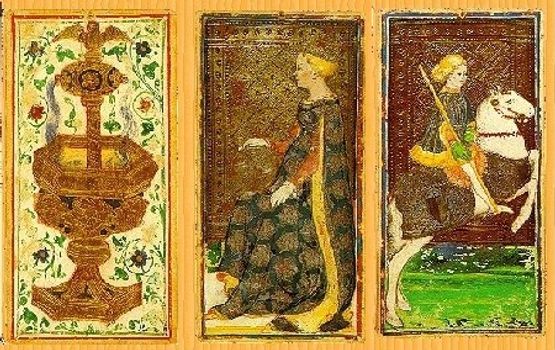
The Oldest Tarot Decks: From Renaissance Luxury to Modern Magic
Where did tarot really begin?
Ask most people, and they’ll tell you tarot is an ancient mystical tool, maybe Ask most people, and they’ll tell you tarot is an ancient mystical tool, maybe Egyptian, maybe the work of medieval witches. The truth? Tarot’s earliest surviving decks weren’t born in secret temples or shadowy covens — they came from the glittering courts of Renaissance Italy, crafted as lavish playthings for nobles.
Still, there’s a deeper current flowing beneath these ornate cards. In The History of Magic, 19th-century occultist Eliphas Lévi proposed that the Jews carried magical secrets out of Egypt and later passed them on, altered and veiled, through the mysteries of the tarot. So even if the cards themselves were painted in Italian palaces, the belief that they channel ancient symbolic power has been woven into tarot lore for centuries.
Let’s trace how these first tarot cards — hand-painted for dukes and duchesses — transformed across time into the powerful decks modern witches use today for insight, spellwork, and personal evolution.
The Visconti-Sforza Decks: Tarot’s Glittering Ancestors
The oldest known tarot decks are the Visconti-Sforza cards, created in the 1440s–1450s in Milan. Commissioned by the powerful Visconti and Sforza families, these decks were pure luxury:
- Hand-painted on heavy cardstock.
- Decorated with shimmering gold leaf and rich pigments.
- Depicting aristocratic figures, mythic scenes, and lush botanical details.
At this stage, tarot wasn’t about fortune-telling. It was a sophisticated game called “trionfi” — meaning triumphs — which combined trick-taking with allegorical images.
Many of these original decks are incomplete today, with missing cards that spark endless mystery. Museums like the Morgan Library in New York and the Brera Gallery in Milan still hold precious surviving examples.
What Did These Early Cards Show?
Even back then, tarot included recognizable figures:
- The Fool (Il Matto) with his whimsical garb.
- The Empress and Emperor, regal and commanding.
- The Wheel of Fortune, reminding players of fate’s constant spin.
However, they lacked the deeper occult meanings we layer on them today. The Major Arcana were moral and social allegories, designed more for playful reflection and bragging rights than for divination.
From Noble Tables to Occult Tools
So how did these gilded game cards transform into a witch’s trusted tool?
- In the 1600s–1700s, tarot spread into France and Switzerland. The famous Tarot de Marseille emerged — simpler lines, bolder colors, mass-printed. Still mostly for card games.
- In the late 1700s, French occultists like Etteilla and later Eliphas Levi began mapping astrology, Kabbalah, and esoteric meanings onto tarot. Suddenly, tarot wasn’t just entertainment — it was a key to the mysteries.
- By the 1900s and beyond, the Rider Waite deck, Thoth deck, and countless modern interpretations exploded onto the scene, each carrying whispers of these early Italian masterpieces.
Why Should Modern Witches Care?
The oldest tarot decks aren’t just museum pieces — they’re living ancestors to your own deck. Here’s why they still matter:
Aesthetic Inspiration: Their art is stunning, earthy, and filled with medieval symbolism that can deepen your own intuitive readings. Even modern decks borrow poses, motifs, and expressions from these originals.
Historical Roots: Knowing where tarot came from grounds your practice. It turns a quick pull of cards into part of a centuries-long lineage.
Ritual Use: Many witches use Visconti-Sforza reproductions today for ancestor work, shadow journeys, or simply to honor tarot’s roots.
Tarot: Always Evolving, Always Enchanting
Who would have thought that a lavish card game painted for Italian dukes would become one of the most beloved spiritual tools in the modern witch’s arsenal? From the gilded courts of Milan to your candlelit altar, tarot has journeyed through time — changing, growing, whispering new secrets to every generation.
So next time you shuffle your deck, pause for a moment. Feel the weight of history there in your hands. The old tarot is still alive, dancing with you in every spread.
Related Articles
The Evolution of Tarot Symbolism: From Medieval Allegories to Today
Explore how tarot symbolism evolved from medieval Italian courts to the Rider-Waite and Thoth decks. Discover the true roots of tarot imagery — beyond the myths.
Learn Tarot Easily with the LVX Tarot Tutor
Discover how you can learn tarot easily through the LVX Tarot Tutor — a conversational guide trained by LVX in the ancient wisdom of the cards. Explore how our carefully trained intelligence brings tarot symbolism, insight, and guidance to life.
What is the Rider Waite Tarot Deck? Origins, Symbolism & How to Read It
What is the Rider Waite Tarot deck? Discover its fascinating origins, rich symbolism, and how to use this iconic deck to unlock your intuition and personal growth.